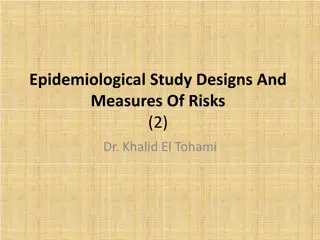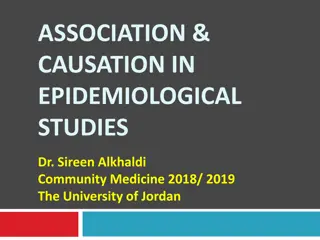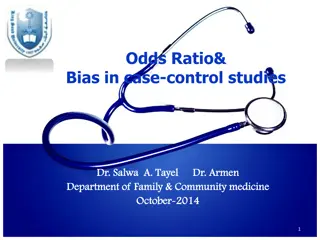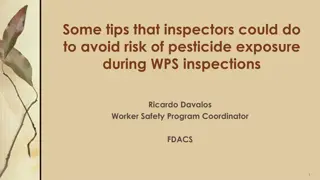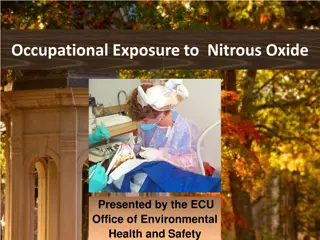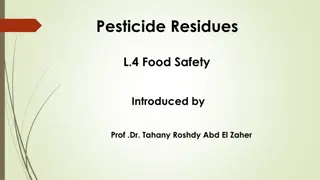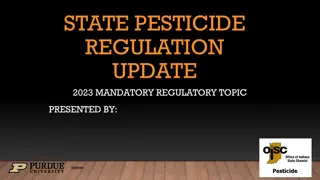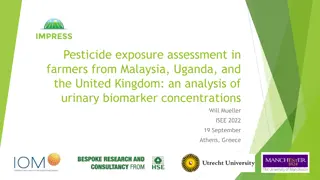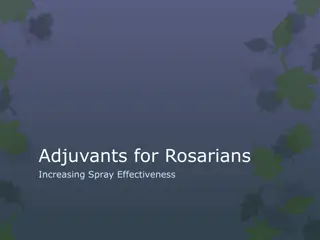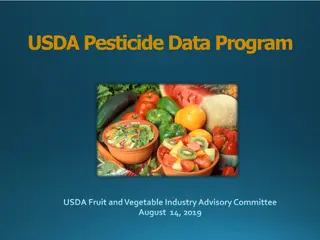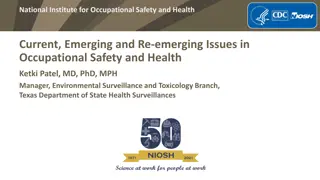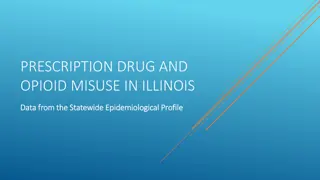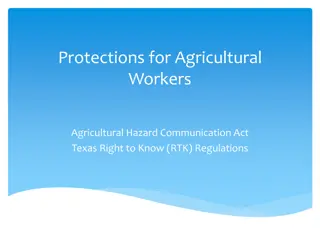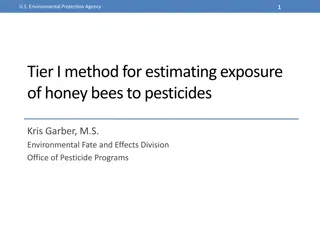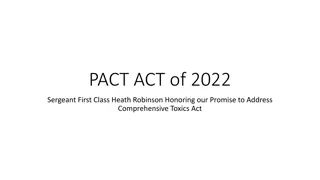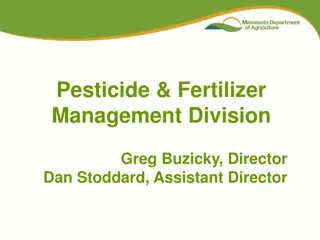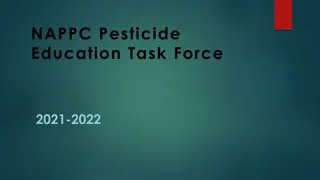Enhancing Pesticide Exposure Assessment for Epidemiological Studies
Focuses on IMPRESS project aiming to improve methodologies for assessing occupational pesticide exposure in epidemiological studies. Reviews challenges in retrospective exposure assessment, proposes methodologies, and presents key project results to date, emphasizing the use of various exposure assessment methods. Discusses the relative frequency and types of exposure assessment methodologies employed in observational epidemiological studies across different countries.
Download Presentation

Please find below an Image/Link to download the presentation.
The content on the website is provided AS IS for your information and personal use only. It may not be sold, licensed, or shared on other websites without obtaining consent from the author. Download presentation by click this link. If you encounter any issues during the download, it is possible that the publisher has removed the file from their server.
E N D
Presentation Transcript
IMPRESS: Improving occupational exposure assessment methodologies (EAMs) for epidemiological studies on pesticides KS Galea, on behalf of the IMPRESS project team Related image
Conflict of interest slide Funding source: Crop Life Europe (CLE) The authors declare no financial conflicts of interest. IMPRESS project team employees of the following organisations: Related image Project Governance: Independent Advisory Board provides independent and impartial expert advice All completed Conflict of Interest forms Project governance document stating agreed roles, responsibilities and interactions of those involved Freedom to publish our project findings
Background Increasing interest in epidemiological studies of pesticide exposed workers For chronic diseases retrospective exposure assessment is challenging Historic measurement data not really available Numerous EAMs, generally not validated IMPRESS project aims to: Search in Scopus for pesticide AND epidemiology AND ( work OR occupational ) Better understand performance of EAMs used in epi. studies Assess reliability and external validity of surrogate measures used to assign exposure within individuals / groups and evaluate size / effects of recall bias on misclassification Provide recommendations for future studies
How did we propose to do this? PIPAH (UK PUHS (UK) SHAW (UK) PESTROP (Uganda) Malaysian farmers (Malaysia) 4
Aim of todays presentation Provide high level overview of key IMPRESS project results to date.
What EAMs are being used? Searched for articles reporting observational epidemiological studies in MEDLINE and Embase published 1993 to 2017. The relative frequency of EAM analysed according to EAM type (direct and indirect methods), health outcome, study design, study location (country) and specificity of assessment. Temporal trends in EAM were analysed. 1271 articles concerned studies performed in 97 countries reviewed
What did our review tell us? In 1298 included articles 1521 EAM occurrences were documented. Indirect EAM (78.3%), primarily self-reported exposures (39.3%) and job titles assessments (9.5%), mainly applied in case-control studies (95.0%), in high-income countries (85.0%) and in studies of doctor-diagnosed health outcomes (>85%). Direct EAM (20.8%), primarily biomonitoring of blood (15.6%) or urine (4.7%), predominantly applied in cross-sectional studies (29.8%), in lower middle-income countries (40.9%) and in studies of neurological (50.0%) outcomes. Between 1993 - 2017, majority of EAM applied were indirect, particularly based on self- reported exposure. Use of self-reported exposures and job exposure matrices increased throughout the study period, Use of expert-assessments and job title assessments decreased. Use of algorithms and predictive models showed no trend. No temporal trends in the use of different direct EAM were observed.
How do the applied EAMs influence risk estimates for some chronic diseases? We conducted three meta-analyses to specifically investigate how the type of EAM influenced summary risk estimates of prostate cancer (PC), non- Hodgkin s lymphoma (NHL) and Parkinson s disease. Influence of EAM type on the summary risk ratio (sRR) of PC (25 articles), NHL (29 articles) and PD (32 articles) was investigated. EAM types analysed were: group-level assessments (eg, job titles), self- reported exposures, expert-level assessments (eg, job-exposure matrices) and biomonitoring (eg, blood, urine). Additionally, sRRs were estimated by study design, publication year period and geographic location where the study was conducted.
What did the meta-analyses tell us? EAM was not associated with significantly different summary risk estimates for any of the analysed health outcomes. Study design (for cancer studies), publication year (for studies on NHL) and geographic region where the study was conducted (for PC), showed a larger effect on the summary risk estimates than the applied EAM. When performing systematic reviews of studies on chronic health effects of occupational pesticide exposure, epidemiological study design, publication year and region where the study was performed, should primarily be considered.
Evaluation of recall of exposure Found occupational epi. studies on pesticide use commonly rely on self-reported questionnaire or interview data Insight into recall accuracy important - misclassification of exposures due to imperfect recall can bias risk estimates
What did we do? We assessed recall by time, contextual factors, and demographic characteristics: 1. Frequency of pesticide use 2. Crops 3. PPE worn 4. Hygiene practices 5. Application methods 6. Active ingredients (Uganda only) Quantitative recall: correlation, regression of geometric mean ratios Binary recall: sensitivity, specificity, overall agreement, area under curve Separately examined UK and Uganda cohorts
What did we learn? UK farmers: Results indicate that recall ability may deteriorate over a longer period. Although low-response rates may require these findings to be interpreted with caution, recall for a number of exposure determinants appeared reliable, such as crops and hygiene practices within 3 years, as well as days per year working with pesticides. Uganda farmers: Smallholder farmers in Uganda could better recollect after a 2-year period the total number of years using pesticides, as well as certain active ingredients and personal protection equipment (PPE), compared to poorer recall of specific crops. More research is needed on recall in poorly educated agriculture communities in low- and middle-income settings to confirm these results.
What are we currently working on? Evaluation of associations between exposure-modifying factors and urine metabolite measurements with contextual data across cohorts (PESTROP, PIPAH / PUHS, Malaysia) Comparison of the performance of alternative EAMS in published1,2 epidemiological studies of health effects from exposure to pesticides Compare pesticide EAMs in the PESTROP Uganda study conducted in 2017 and 2019. Several different exposure metrics will be generated for four (groups of) active ingredients, these being glyphosate, mancozeb, chlorpyrifos and the chemical group pyrethroids Compare exposure-response associations for several proxies/metrics of pesticide exposure, with neurobehavioral outcome variables as assessed in 2017 and for several proxies/metrics of pesticide exposure with sleep problem indices as assessed in 2019. Publications to follow! 1 Exposure to multiple pesticides and neurobehavioral outcomes among smallholder farmers in Uganda. Fuhrimann S, et al. Environ Int. 2021 Jul;152:106477. doi: 10.1016/j.envint.2021.106477. Epub 2021 Mar 20. 2 Recent pesticide exposure affects sleep: A cross-sectional study among smallholder farmers in Uganda. Fuhrimann S, et al. Environ Int. 2022 Jan;158:106878. doi: 10.1016/j.envint.2021.106878. Epub 2021 Sep 27.
IMPRESS peer-reviewed publications to date Jones K, et al (2020) Improving Exposure Assessment Methodologies for Epidemiological Studies on Pesticides: Study Protocol JMIR Res Protoc 2020;9(2):e16448. DOI: 10.2196/16448. Mueller W, et al (2022) Recall of exposure in UK farmers and pesticide applicators: trends with follow-up time, Annals of Work Exposures and Health, 2022;, wxac002, https://doi.org/10.1093/annweh/wxac002. Mueller W, et al (2022) Evaluation of two-year recall of self-reported pesticide exposure among Ugandan smallholder farmers. International Journal of Hygiene and Environmental Health; 240. https://doi.org/10.1016/j.ijheh.2021.113911. Ohlander J, et al. (2022) Impact of occupational pesticide exposure assessment method on risk estimates for prostate cancer, non-Hodgkin s lymphoma and Parkinson s disease: results of three meta-analyses. OEM. Published Online First: 07 April 2022. doi: 10.1136/oemed-2021-108046. Ohlander J, et al (2020) Systematic review of methods used to assess exposure to pesticides in occupational epidemiology studies, 1993 2017. Occupational and Environmental Medicine Published Online First: 25 February 2020. doi: 10.1136/oemed-2019-105880



